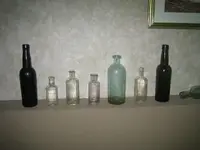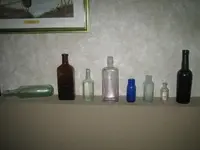BOTTLE BASICS
Digger Odell Publications © 2003
How to Tell the Age of a Bottle: Lips
Beginning collectors often wonder how to tell the age of a particular bottle.One of the most important clues to the age of a bottle is the style of the lip. In the picture below are shown a number of lip styles common during the last century.
Lips of Nineteenth Century Bottles
All of the above lips were applied to the neck of the bottle after it was removed from the mold. A hot piece of glass was applied to the neck and then hand tooled to the proper shape. The lips of bottles made before 1870 were often crudely applied and careful examination shows these irregularities. Sometime around 1880 it became common practice to tool the lips with a lipping tool, an object which fit one piece into the opening of the neck while two other pieces clamped on the outside of the applied band of glass. Then with a twisting motion, the top was uniformly shaped. Bottles produced during the last twenty years of the last century will show evidence of this twisting motion which left faint concentric rings around the mouth and upper part of the neck. This motion also erased the mold seam in the process. This is shown in the picture below on a bottle made sometime between 1890 and 1910. The lip, a round band, was finished with a lipping tool which erased the mold seam and left its tell tale concentric rings. Earlier bottles, those made before 1870, will not show these rings and lip may be more crudely applied with some drippy areas under the applied band. When the mold seam stops before the top of the bottle then the bottle is said to have been hand finished..
How to Tell the Age of a Bottle: Bases
Looking at the base of a bottle is also helpful in determining the age. Most bottles made before 1858 will have a "pontil" mark. This mark was left when the "punty rod" was snapped off the bottom of the bottle. The punty rod was used to hold the hot bottle while the lip was formed and finished. The punty rod was dipped into hot glass and attached to the base of the bottle by one of the helpers. The glassblower then formed the lip in the appropriate style and the punty rod was broken off. In the picture are samples of the most common types of "pontil marks". Larger bottles and especially soda bottles made between 1840 and 1855 have pontil marks. Most bottles dating before 1855 will have an open pontil. There are several types of open or pontil marks but the key is the presence of a rough area on the base.
THE OPEN PONTIL IS MORE
COMMON THAN IRON PONTIL
A BROWN OR REDDISH RESIDUE WAS LEFT
EMBEDDED IN THE GLASS WHEN THE
BOTTLE WAS IRON PONTILED.
Other Types of Bases
The practice of using private molds became popular around of the middle of the nineteenth century. These mold were ordered from the glass factories by medicine manufacturers, soda and mineral water bottles and manufacturers of other household goods. Private molds could be had with embossing or for bottles of unusual design. Embossed bottles became commonplace.
Sometime around 1855 a tool called a snap case was invented which allowed the glassblower to hold the bottle for finishing without using a punty rod. the snap case left no marks and more importantly no pontil. Molds were designed with a particular base called a "key mold" this mold left a distinctive mark on the base of bottles made between 1850-1870. Key mold bottles can be found both pontiled and smooth based
Bitters Bottle Base Showing Key Mold Circa 1870
Smooth Base Bottles
As mold making technology progressed the seam across the base of the bottle disappeared. Embossed bases became more common and other markings began to appear on bottle bases such as initials for the glass works producing the bottles. For the period from 1870-1910 bottles had hand tooled lips and smooth bases. Then in 1892 a semi-automatic bottle machine was invented. With this machine the entire lip was molded along with the body of the bottle and the need for hand finishing disappeared. Early machine made bottles carry a distinctive mark known as the Owens ring, named after the inventor of the automatic machine at the Owens Glass Company. The fruit jar shown below was made about 1920 and shows the Characteristic Owens ring. By the mid 1920's every bottle was being massed produced by machinery and the era of the hand blown bottle ended. All machine-made bottles have the mold seam go up and over the lip. The letters ABM (automatic bottle machine) are used to refer to these bottles.
A machine made bottle base
In the photograph there is a smaller ring and then a larger one (not as clearly visible). The larger one is the Owen's ring. Both rings are very symmetrical and did not leave a rough mark like the punty rod. Around the turn of the century, the typical color of glass used for bottles changed from aqua to clear. Fewer bottles were embossed and by the late 1930's and into the 1940 and 1950s, painted label bottles (especially for soda and milk bottles) became popular. Bottles lost their individuality as food manufacturers demanded more regular containers, bubbles and the charming irregularities that collectors love disappeared as the 20th century progressed.
(Copyright 1998 by Digger Odell Publications)
HOME (You'll love the rest of my website)
SEARCH THIS SITE
BOTTLE INFO
• Home
• Digger's Books
• Bottle Values
• Email Appraisals
• Ask Digger
• Sell Your Bottles
• Privy Digging
• Cleaning Bottles
• Bottle Brushes
• Bottles for Sale
• Dating Bottles
ARTICLES FROM DIGGER
• Bottle Basics
• Reproductions
• Fed. Law Prohibits
• The Hires Story
• Drug Bottles
• Codd Bottles
WHAT'S VALUABLE?
• Appraisals
• Black Glass
• Fruit Jars
• Whiskey Bottles
• Bitters Bottles
• Blown Bottles
• Soda Bottles
• Saratogas
• Apothecary
Digger Odell Publications Copyright 2007









